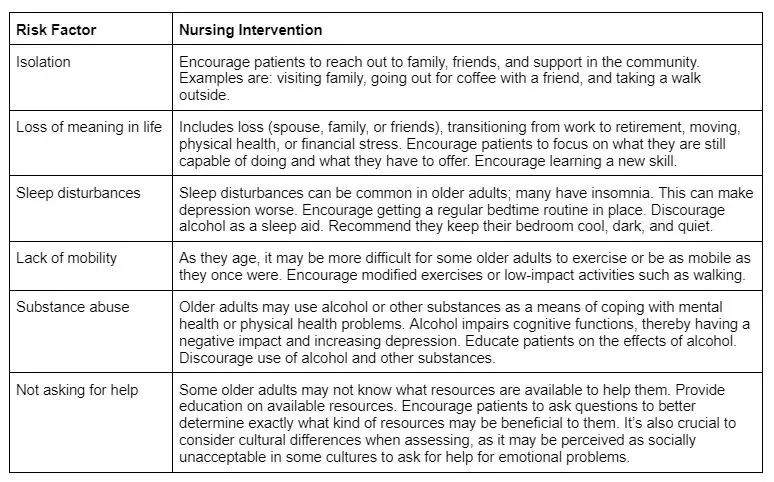The prevalence of depression among older adults is quite common. However, it does not necessarily mean that it’s normal. In many cases, older adults who experience depression do not receive the treatment they need.
A major reason for this is how depression presents itself in this age group (those who are over the age of 65). Symptoms of depression can be masked by, or confused with, the effects of age-related cognitive defects, health problems, and the medications to treat them.
Depression in older adults
Quality of life can be negatively affected by depression, and suicide risk increases, especially among older adult men. Also, there is a strong link between depression and cardiovascular diseases, which can lead to an increase in deaths after a heart attack. Generally, adults who have a high incidence of depression, have a higher risk of suffering cardiovascular disease, stroke, and heart attack.
Factors that contribute to depression in the elderly include:
- Death of a spouse
- Social isolation
- Leaving the workforce and transitioning to retirement
- Moving from home to an assisted living facility
- Chronic medical conditions
- Pain
- Decreased mobility or loss of mobility
- Dementia or Alzheimer’s disease
- Loss of independence
- Chemical imbalances
- Prolonged drug or substance abuse over the years
- Genetics – a family history of depression
As we can see, the list is lengthy, and this doesn’t include all the potential causes that can bring on depression in adults.
When working with older adults, it’s important to be aware of behaviors that can be an early indicator of depression. Keep the following behaviors in mind
Indicators of depression:
- Sleep disturbances: sleeping too much or too little
- Change in appetite: increased or decreased
- Does not answer phone calls or the door
- Is unable to get dressed (often caused by aging)
- Feelings of worthlessness and sadness
- A sudden display of crying, agitation, and anger
- Isolation from others
- Mood instability
- Lack of interest or enjoyment in things they used to love
- Discussing suicide
- Difficulty concentrating
- Coping difficulties
- Memory problems
Nursing interventions for depression include standardized screening tools for assessing older adults for depression or risk of depression. By using these tools, nurses can identify key issues and intervene when necessary.
The Geriatric Depression Scale
The Geriatric Depression Scale is a standard screening tool used extensively with older adults. The patient answers 30 questions by selecting either yes or no, depending on how they feel. There is also a shorter version of the scale that consists of 15 years or no questions.
This scale is used to assess healthy older adults, medically fragile older adults, and older adults with mild to moderate cognitive impairments. This screening tool is just that—a way to screen patients. It’s not a diagnostic interview.
It’s to be used in a home or clinical setting to assess whether an older adult is depressed or at risk of becoming depressed. The goal of this tool is to assess whether the older adult being screened needs intervention and/or treatment for depression.
The Nurses’ Global Assessment of Suicide Risk
The Nurses’ Global Assessment of Suicide Risk (NGASR) is another effective nursing intervention tool. The NGASR aids in assessing and measuring depression and suicide risk in older adults. The assessment examines the following categories:
- Suicidal thoughts
- Health problems
- Symptoms of depression
- Planning and execution
- Stressors
- Intoxication
- Possession of firearms or other lethal means
Additionally, risk assessment identifies whether patients have protective factors against suicide. Examples of such protective factors are:
- Resources and support
- Family or community relationships
- Continual medical support and management
- Cultural beliefs
- Sense of belonging to their community
- Taking care of family/pets
In addition to identifying whether the individual has had suicidal thoughts, it also indicates how prevalent those thoughts have been. It examines:
- Ideation and implementation
- Planning and intent
- Intention and plans of when to commit suicide
All of this data may be used to determine the patient’s level of risk—whether they are low risk, moderate risk, or high risk for suicide. Using this information can assist in designing a plan of intervention or either inpatient hospital admission, outpatient treatment, crisis management, safety precautions, or professional services.
DSMV: Diagnostic Statistical Manual of Mental Disorders
The Diagnostic Statistical Manual of Mental Disorders (DSMV) is another effective nursing intervention tool. It consists of descriptions, symptoms, and diagnostic criteria for mental disorders. It is primarily used for diagnosis.
These screening tools are useful for the nurse to assess for depression and provide the appropriate interventions.
Client-Centered Approach and Recovery Module
Client-centered approaches and recovery modules are essential components of nursing interventions for depression. In this approach, the following are taken into account:
- Respect for the patient’s wishes, expressed needs, and values
- Integration and coordination of care (interdisciplinary plan)
- Inform and educate
- Assure physical comfort
- Assure emotional support (alleviate worry and fear)
- Include family and friends (recognize the need for family and friends, be supportive of family and friends, and involve them in decision-making when appropriate)
- Discharge and follow-up (provide ongoing care and services)
- Access to care (being able to receive care when needed)
- Spiritual and cultural needs
These factors make it possible for patients to be active participants in their recovery and treatment. The patient’s dignity and respect are paramount. Having a place to develop their strengths, gain self-esteem, and being allowed to use their strengths and direct their own recovery is crucial to their overall mental health.
Treatment and interventions include:
- In-home visits
- Reducing risk factors
- Determining the risk factors can help reduce depression
Risk Factors and Interventions
Early Detection
Early detection is an important and effective nursing intervention. Early detection can help assess and identify risk factors for depression and depressed patients. Maintaining contact with and monitoring older adults can also ensure they are kept informed about social connections within their community.
Providing older adults with the appropriate resources, as well as social interaction with their peers, can ensure their continued well-being and optimal recovery.
Resources For Older Adults
Support Groups
There are support groups for everything, including depression, grief, and health problems. These groups can provide patients with support in a non-medical area. Members of these groups have similar experiences and come together to share stories, struggles, and coping strategies. Members of these groups provide support, empowerment to one another, and offer a sense of community.
Senior Centers
Senior centers offer social gatherings, concert nights, games, outdoor activities, potlucks, day trips, crafts, educational programs, movie nights, and any other various activities one may be interested in.
Home Support Groups
Home support groups offer non-medical related services such as shopping, errands, transportation services, and visitation.
Meal Deliveries
Meal deliveries are services for older adults that can’t prepare meals. Older adults may not be able to prepare meals due to cognitive deficits and/or decreased mobility.
A variety of services provide meals to older adults at reduced cost and deliver them directly to the patients’ homes. Find out if there are any programs available in your area that you can share with your patients. These services are so important to ensure patients are receiving adequate nutrition.
Housekeeping Services
Some older adults have difficulty maintaining their homes, but they don’t want to move to an assisted living center, or they can’t afford to do so. Housekeeping services can help older adults with preparing meals, grocery shopping, laundry, washing dishes, and various other household tasks.
Conclusion
Nursing interventions, including using the above screening tools and resources, reduce depression risk factors in older adults. Educate your patients on what depression is, the symptoms of depression, and the importance of following a treatment and medical management plan.
The continued monitoring of a patient can reduce episodes of depression, enable medication management and increased access to resources, as well as increase security and well-being.
Written by Joanne Potter
Joanne, BSN and RN, is a writer that specializes in health and wellness. She has fifteen years of experience as a Registered Nurse in the NICU (Neonatal Intensive Care Unit). Her years working at the bedside and extensive neonatal knowledge enable her to write with a deep understanding of what patients and families want from their communities. Visit her LinkedIn page.










